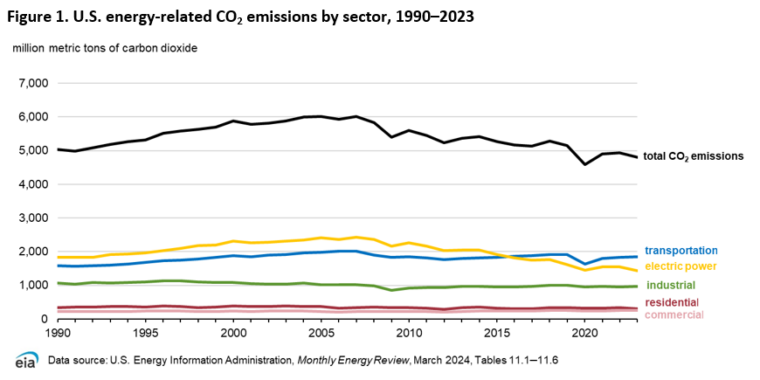[
On Thursday, the US Department of Energy released its preliminary estimate for the nation’s carbon emissions in the previous year. Any drop in emissions puts us on a path that would avoid some of the catastrophic warming scenarios that were still on the table at the turn of the century. But if we’re to have a chance of meeting the Paris Agreement goal of keeping the planet from warming beyond 2° C, we’ll need to see emissions drop dramatically in the near future.
So, how is the US doing? Emissions continue to trend downward, but there’s no sign the drop has accelerated. And most of the drop has come from a single sector: changes in the power grid.
Off the grid, on the road
US carbon emissions have been trending downward since roughly 2007, when they peaked at about six gigatonnes. In recent years, the pandemic produced a dramatic drop in emissions in 2020, lowering them to under five gigatonnes for the first time since before 1990, when the EIA’s data started. Carbon dioxide release went up a bit afterward, with 2023 marking the first post-pandemic decline, with emissions again clearly below five gigatonnes.
The DOE’s Energy Information Agency (EIA) divides the sources of carbon dioxide into five different sectors: electricity generation, transportation, and residential, commercial, and industrial uses. The EIA assigns 80 percent of the 2023 reduction in US emissions to changes in the electric power grid, which is not a shock given that it’s the only sector that’s seen significant change in the entire 30-year period the EIA is tracking.

With hydro in the rearview mirror, wind and solar are coming after coal and nuclear.
What’s happening with the power grid? Several things. At the turn of the century, coal accounted for over half of the US’s electricity generation; it’s now down to 16 percent. Within the next two years, it’s likely to be passed by wind and solar, which were indistinguishable from zero percent of generation as recently as 2004. Things would be even better for them if not for generally low wind speeds leading to a decline in wind generation in 2023. The biggest change, however, has been the rise of natural gas, which went from 10 percent of generation in 1990 to over 40 percent in 2023.
A small contributor to the lower emissions came from lower demand—it dropped by a percentage point compared to 2022. Electrification of transport and appliances, along with the growth of AI processing, are expected to send demand soaring in the near future, but there’s no indication of that on the grid yet.
Currently, generating electricity accounts for 30 percent of the US’s carbon emissions. That places it as the second most significant contributor, behind transportation, which is responsible for 39 percent of emissions. The EIA rates transportation emissions as unchanged relative to 2022, despite seeing air travel return to pre-pandemic levels and a slight increase in gasoline consumption. Later in this decade, tighter fuel efficiency rules are expected to drive a decline in transportation emissions, which are only down about 10 percent compared to their 2006 peak.
Buildings and industry
The remaining sectors—commercial, residential, and industrial—have a more complicated relationship with fossil fuels. Some of their energy comes via the grid, so its emissions are already accounted for. Thanks to the grid decarbonizing, these would be going down, but for business and residential use, grid-dependent emissions are dropping even faster than that would imply. This suggests that things like more efficient lighting and appliances are having an impact.
Separately, direct use of fossil fuels for things like furnaces, water heaters, etc., has been largely flat for the entire 30 years the EIA is looking at, although milder weather led to a slight decline in 2023 (8 percent for residential properties, 4 percent for commercial).
In contrast, the EIA only tracks the direct use of fossil fuels for industrial processes. These are down slightly over the 30-year period but have been fairly stable since the 2008 economic crisis, with no change in emissions between 2022 and 2023. As with the electric grid, the primary difference in this sector has been due to the growth of natural gas and the decline of coal.
Overall, there are two ways to look at this data. The first is that progress at limiting carbon emissions has been extremely limited and that there has been no progress at all in several sectors. The more optimistic view is that the technologies for decarbonizing the electric grid and improving building electrical usage are currently the most advanced, and the US has focused its decarbonization efforts where they’ll make the most difference.
From either perspective, it’s clear that the harder challenges are still coming, both in terms of accelerating decarbonization, and in terms of tackling sectors where decarbonization will be harder. The Biden administration has been working to put policies in place that should drive progress in this regard, but we probably won’t see much of their impact until early in the following decade.
Listing image by Yaorusheng







